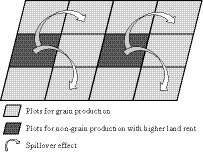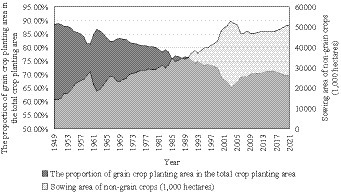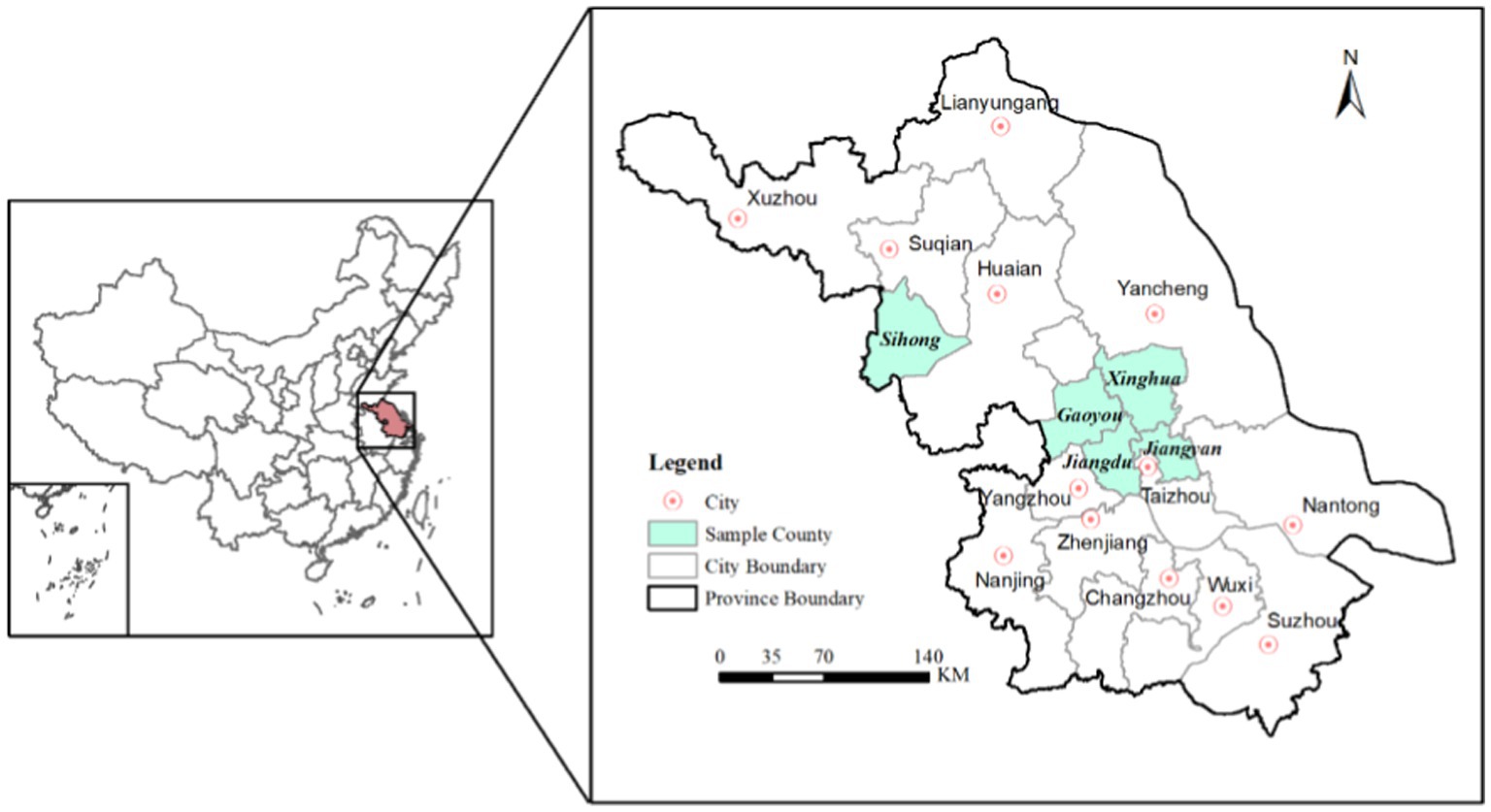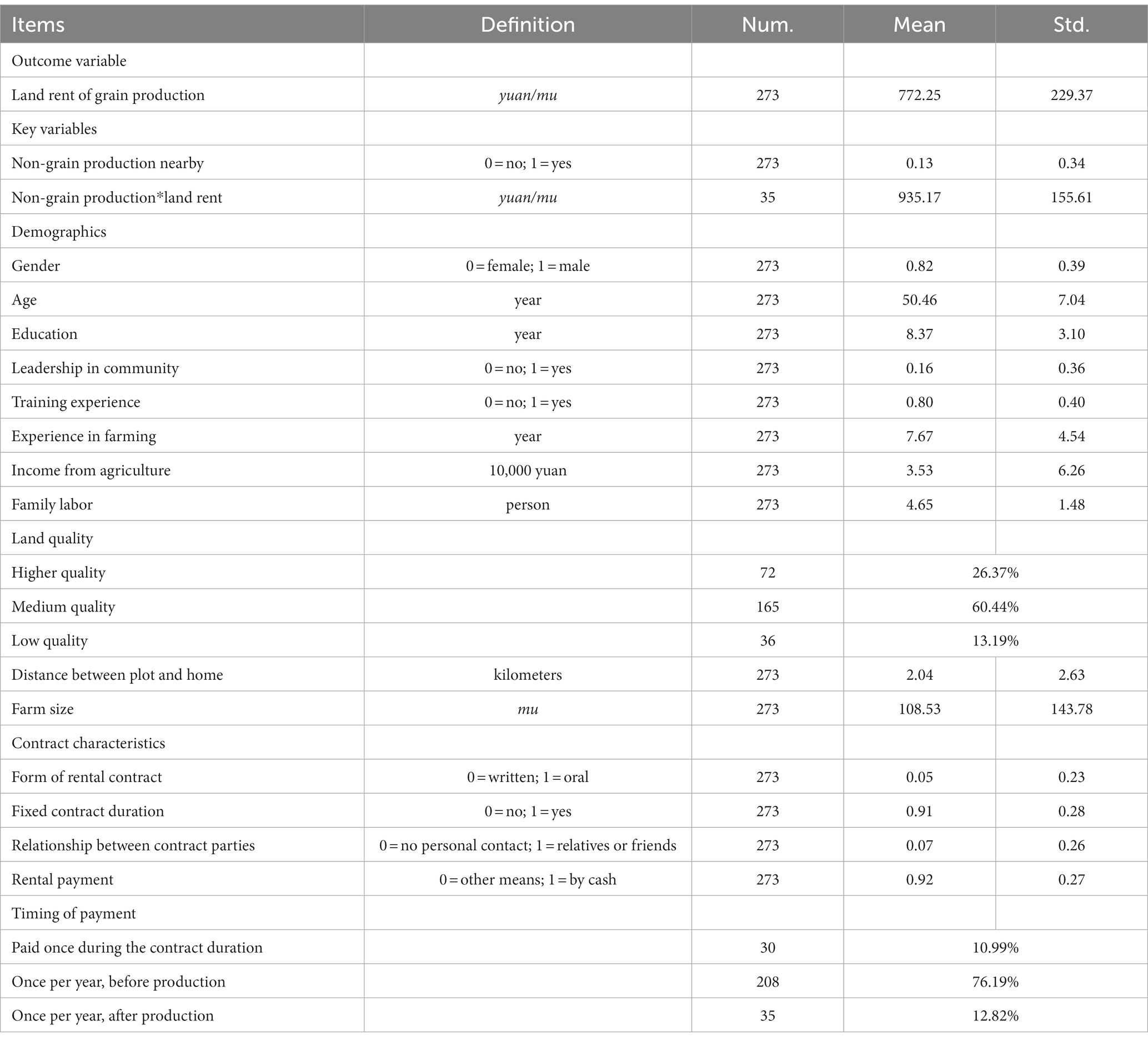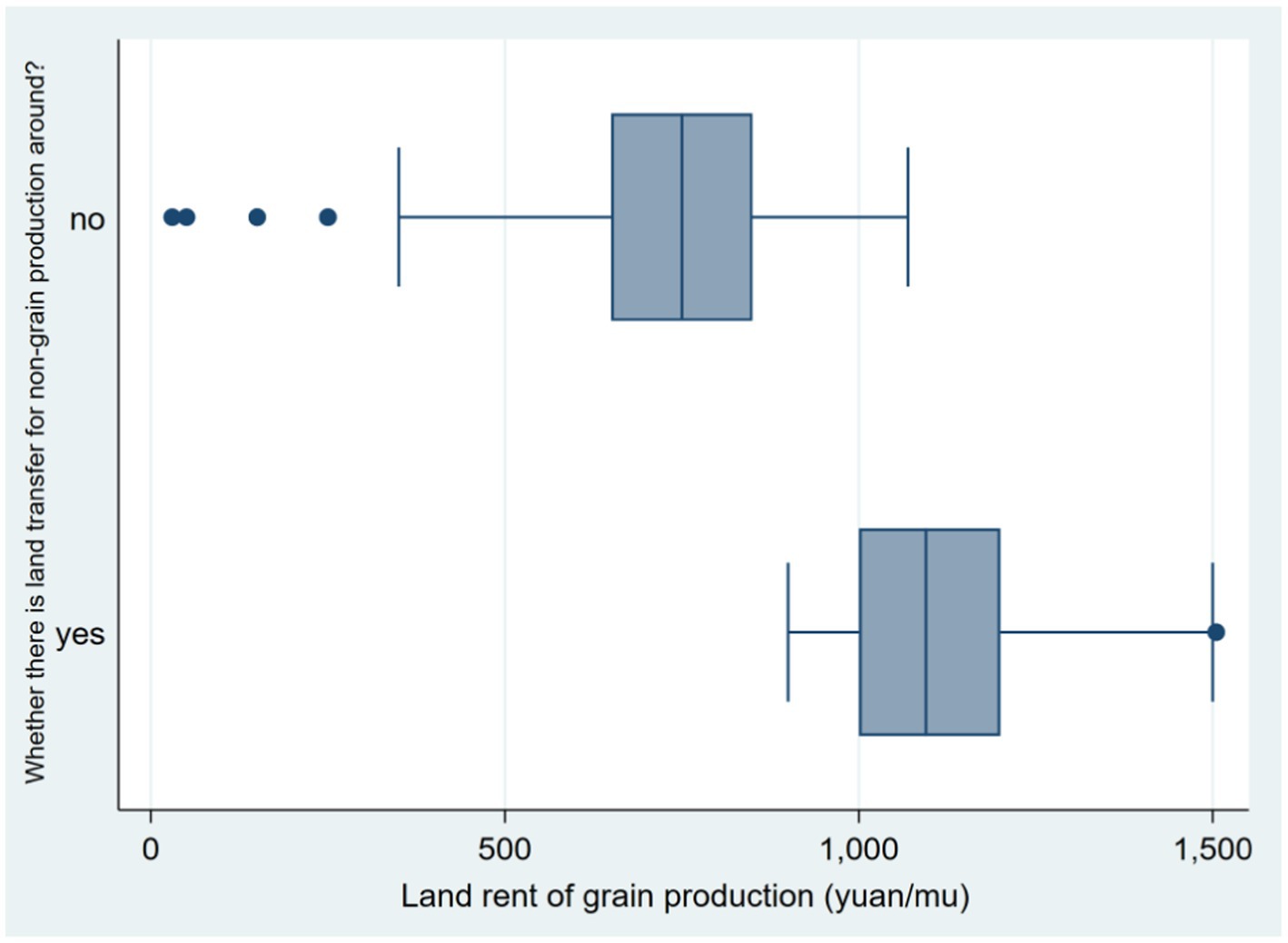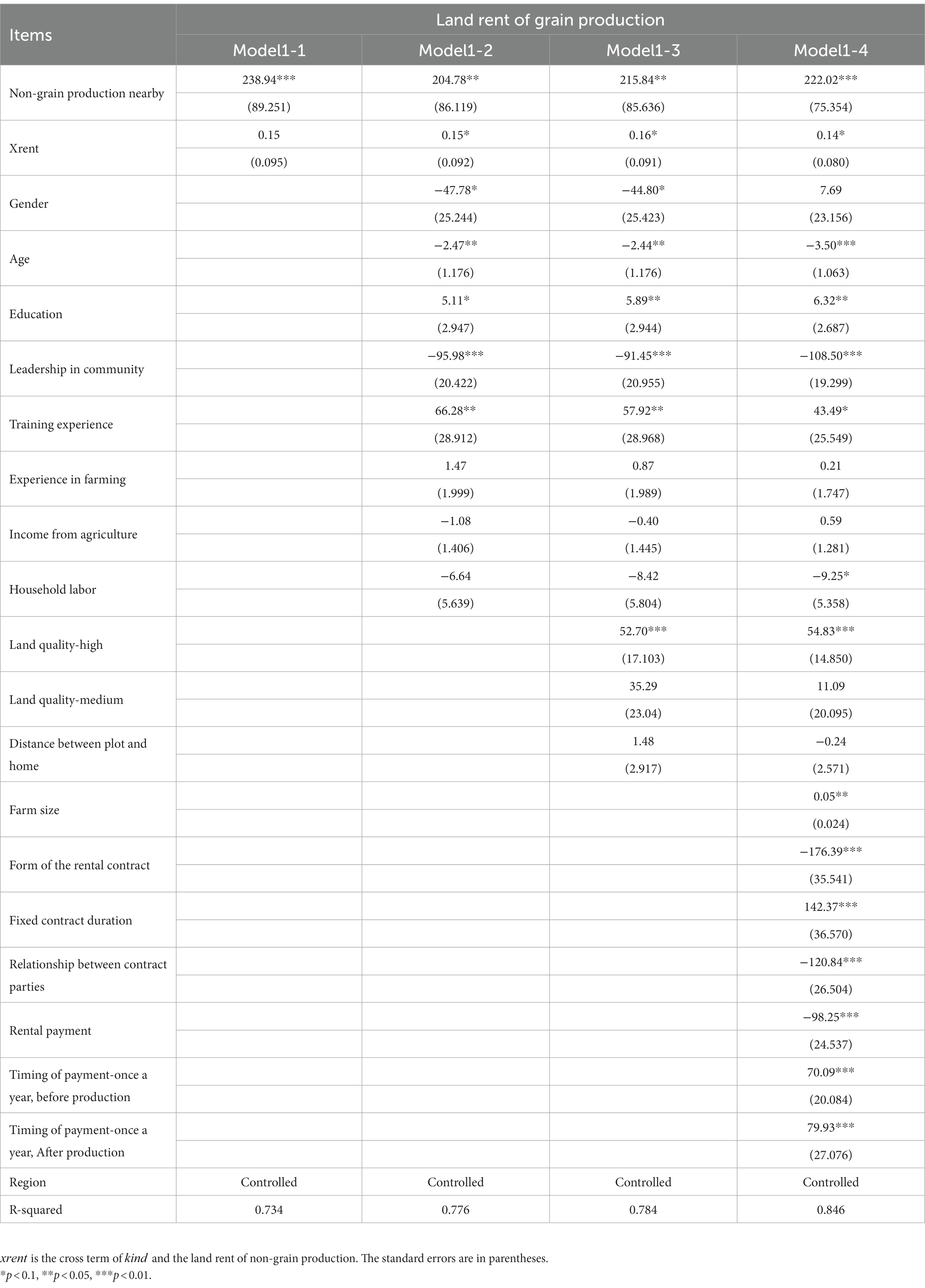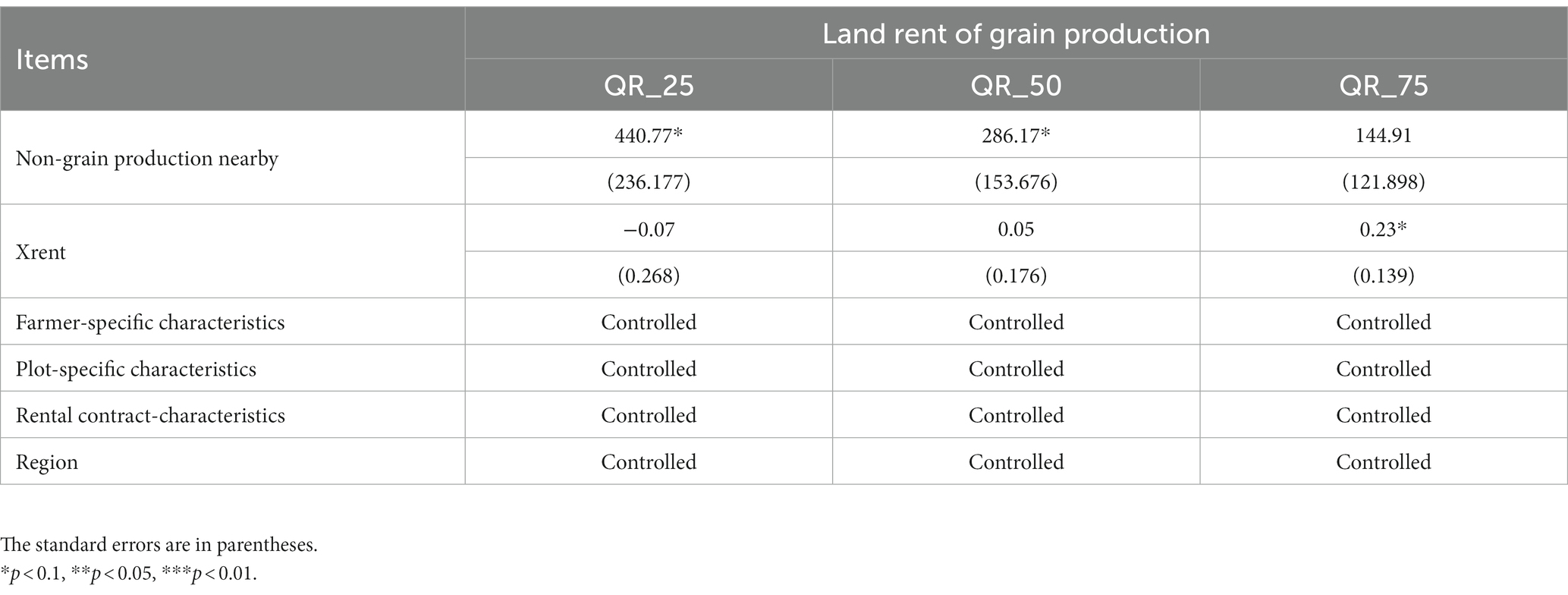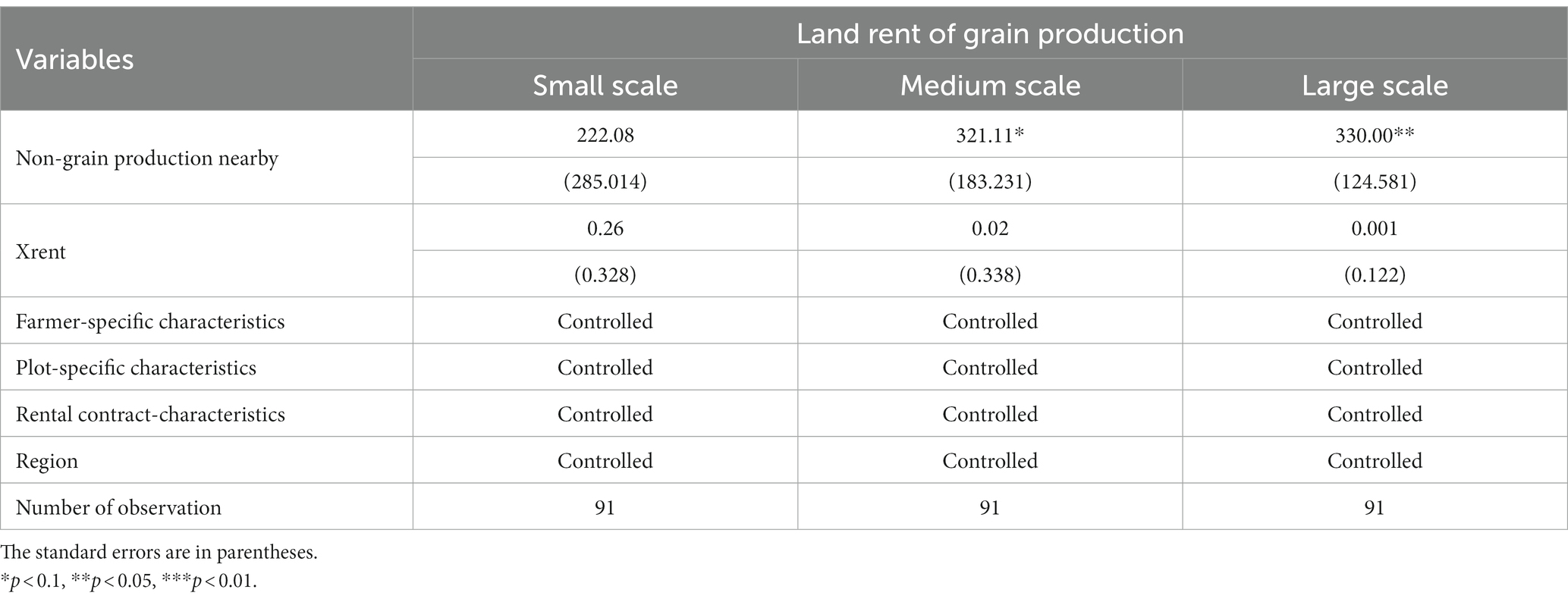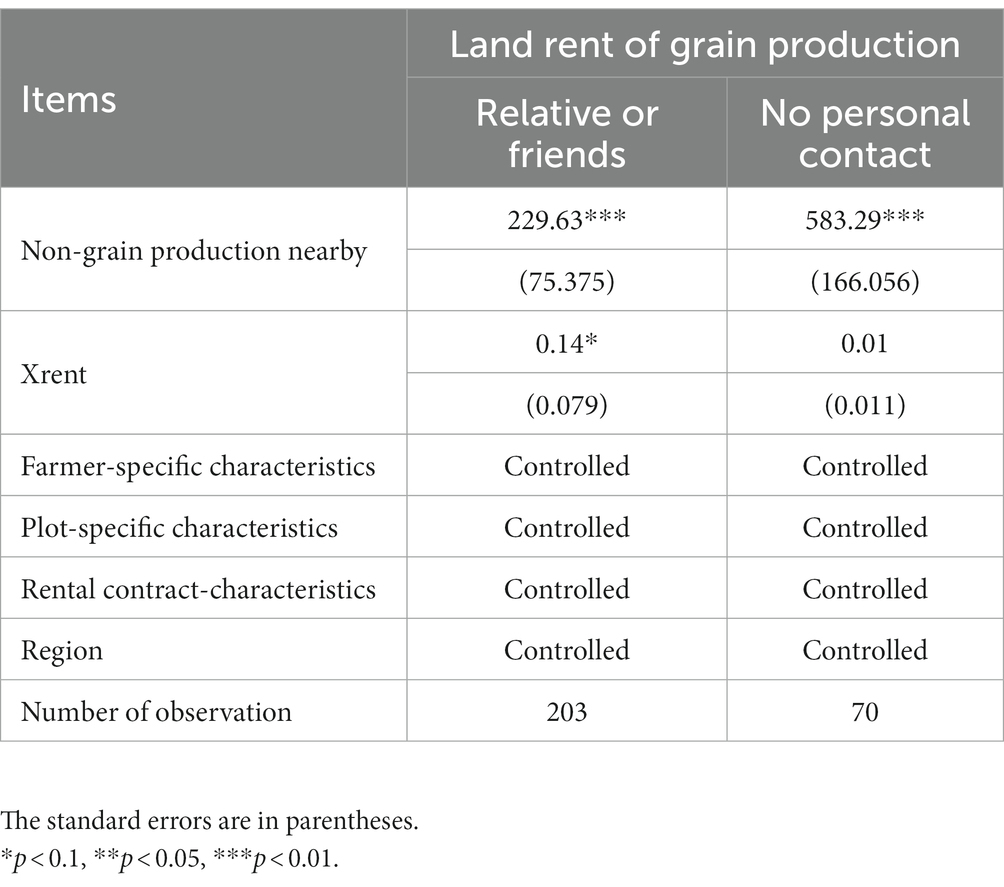- 1Nanjing University of Finance and Economics, Nanjing, Jiangsu, China
- 2Nanjing University of Posts and Telecommunications, Nanjing, Jiangsu, China
- 3Jiangsu Academy of Agricultural Sciences (JAAS), Nanjing, China
Introduction: Crop diversification from grain to non-grain production is often considered a threat to food security in many populous countries with limited arable land. Yet its potential spillover effect has not been fully studied. This study explores a unique plot-level dataset to particularly quantify the spillover effect of non-grain production on the land rental price of grain production from the perspective of factor opportunity cost and proposes corresponding land management strategies.
Methods: Data used in this study came from a field survey conducted in Jiangsu province. OLS method was employed to test the effect of non-grain production on the rent price of grain production farmland, combined with plot-level heterogeneity analysis. In addition, Quantile method was used for robustness check.
Results: Our main finding indicates that converting land use from grain production to non-grain production significantly increases the land rental rate of surrounding plots for grain production by 222.02 yuan/mu, accounting for 28.75% of the total land rent (772.25 yuan/mu). This spillover effect exhibits a stronger trend as the contracted land scale expands. However, the kin relationship among contract parties can weaken this effect, indicating that social ties can work as a mediator in offsetting the negative shock of the rental rate increase due to non-grain production. In order to keep the land rent under control, rural land use is actively harnessed by local governments at a guided price.
Discussion: Based on the empirical results, the study recommends comprehensive land use planning and a regionally regulated land transfer market in order to achieve a balance between food security and a diversified agricultural structure.
1 Introduction
The farmland use transition to non-grain production has become a widespread phenomenon in China, especially in coastal and central granary areas where arable land is of high quality (Tang et al., 2021). Grain acreage has witnessed a consecutive decline since 2016. In 2019, it dropped to 116063.6 thousand hectares, only accounting for 69.95% of total cultivated areas for all kinds of crops. This fact indicates that grain production and food security may be faced with new risks despite a series of supportive policies aimed at improving farmers’ willingness to plant grain crops. Non-grain production is defined as the conversion of large quantities of farmland to other crops, such as nursery plantations, cash crops, and poultry farming. Intuitively, a farmer’s crop selection is heavily driven by the comparative profit of different crops. Rapid urbanization and economic progress dramatically change consumers’ daily eating patterns from a carbohydrate-oriented style to a more diversified habitat, leading to more consumption of vegetables, fruits, and protein. This demand-side switch transmits from the price mechanism and causes a lower profit from grain production (Yu, 2018). Data in the National Compilation of Cost–Benefit of Agricultural Products adds evidence to this conclusion. In 2018, the average production cost of rice, wheat, and soybeans in China was 526.49 yuan/mu1 while the average profit from these three crops was only 481.69 yuan/mu, resulting in a cost–benefit rate of −7.83%. This figure declined by 14.94% compared with 5 years ago. At the same time, the average cost–benefit rate of vegetables was 39.14%, and the value of apples was 53.29%. The noteworthy profit disparity between cereal crops and cash crops attracts farmers to non-grain production in spite of higher production risk and investment.
Although non-grain production brings wealth to farmers and prevents further rural–urban income gaps, it cannot be ignored that the major aim of farmland use is to provide sufficient food and ensure food security through political means (Leonhardt et al., 2019; Tongwei et al., 2020). This is not only for China but also essential at the global level (Aziz et al., 2021a, 2022). In the post-epidemic era, climate change, constraints on resources, the COVID-19 pandemic, and geopolitical conflicts amplify food security, particularly in developing countries (Koondhar et al., 2021; Aziz et al., 2021b). Thus, maintaining food affordability and ensuring the benefits of agricultural progress reach a broader population are of great importance. To achieve this goal, food security has been put on the top agenda by the Chinese government. The principle of agricultural and farmland policy is to ‘ensure the basic supply of cereal and the absolute self-sufficiency of grain ration’. In 2022, the Central First File stressed again that non-grain production should be alerted and food security should be achieved through 0.65 trillion kilograms of grain production.
While a large body of studies have focused on the driving force of increasing farmland rent (Kan, 2021; Sikorska, 2010), the effect of non-grain production has received less attention. Dating back to the early days when land transfer was allowed, food security was hardly maintained, resulting in insufficient cereal provision. Under this circumstance, the use of farmland was strictly charged by the government. Restrictions on land use had been gradually removed when grain output experienced a continuous increase, along with rapid demand for diversified agricultural products. As market mechanisms are an essential symbol of the development of the land transfer market (Coelli et al., 2002; Olagunju et al., 2022), non-grain production of farmland is par for the cause considering its higher return to land. Governments in some areas tacitly approve of this land use change; some even encourage it (Wu et al., 2019; Qian et al., 2022; Shi, 2022). With the emergence of non-grain production, land use has been expanded, hand in hand with the enhanced potential value (Lai et al., 2014; Qiu et al., 2021). Zhang et al. (2023) focus on the Guanzhong Region in China and find that non-grain production of cultivated land (NGPOCL) had become worse between 2000 and 2018. The NGPOCL severity and area increased by 10.79 and 31.30%, respectively. Wu et al. (2023) explore a similar trend in the non-grain production of cultivated land, especially after 2017. Farmers need to pay higher rent to rent in the land, no matter the plots are used for grain production or non-grain production purpose (Tang et al., 2021).
Several studies have investigated the effects of non-grain production. Environmentally, the conversion to non-grain production can lead to severe pressure on the local environment by accelerating soil erosion, threatening local biodiversity, and aggravating non-point source pollution (Ziegler et al., 2009; Quinn et al., 2015; Chatvijitkul et al., 2017; Bussi et al., 2018). In terms of socio-economic impacts, this change may pose a threat to food security by altering agricultural structures. For instance, Ge et al. (2018) constructed a per capita farmland area (PCEA) metric and found that farmland transition was driven by changes in agricultural labor, which led to grain production to spatial difference, i.e., South China experienced a declining trend in grain production. Another line of research investigated this effect from the perspective of time and space. Yue et al. (2019) used multi-temporal high-resolution aerial photographs from 2005 to 2015 in China to investigate the trends of four categories of non-grain production (pond farming, duck rearing, nursery plantation, and vegetable production). Their results revealed that non-grain production exhibited strong spatial auto-correlation and conspicuous regional disparities due to local traditions and the clustering effect.
Non-grain production increases the cost of grain production by improving the opportunity cost of land (Haile et al., 2014; Su et al., 2019). It is widely believed that comparative low benefit leads to non-grain production, and grain acreage will increase following the increase in grain price (Su et al., 2019). However, there is also contradictory evidence. Tang et al. (2021) found that the potential value of farmland may be changed with its use transition, and it can also lead to a spatial spillover effect on adjacent plots. Benefits from cash crops are generally higher than those from cereal crops. Thus, non-grain production is an activity with high input and high return. This will further increase the opportunity cost of grain production and lower its benefits. Grain production costs are dominated by labor costs, land rent, and material fees. Considering the expansion of the chemical industry and the development of social services, adverse effects brought by non-grain production on labor costs and material fees will be tampered with. The other important cost, land rent, however, will increase due to the inelastic supply of farmland.
In light of these considerations, it is of interest to investigate the exact effect of non-grain production on farmland rent. The aims of this study are (1) to test the hypothesis that farmland use transition to non-grain production has a positive spillover effect on the land rent of grain production and (2) to investigate the circumstances of farmers’ characteristics and governmental intervention that may cause or counteract this purposed relationship. To address both aims, we first use basic regression analysis of first-hand survey data, both at the farmer and plot level. To obtain a deeper insight into the heterogeneity of this relationship, we then employ quantile regression and divide the full sample into subgroups. The present study contributes to the literature on non-grain production and food production in three aspects. First, we try to find a pathway to maintain the balance between grain production and crop diversity to meet the dual goals of food security and food diversification. Non-grain production on cropland should be clustered to avoid widespread negative spillover effects. Second, it is an attempt to enrich the body of literature by expanding its study perspective from opportunity production cost, while existing research mainly focuses on how non-grain production affects the sown area of food crops. Third, we also propose farmland governance strategies in order to control the land rent for grain production at a reasonable level by introducing guided prices and informal land contracts.
The remainder of the study is organized as follows: Section 2 provides background information and a theoretical framework. Section 3 portrays the data sources and empirical strategy applied in this study. Section 4 presents the main results of the empirical analysis. The last section draws conclusions and proposes some policy implications based on previous analysis.
2 Farmland rental market in rural China
As land is an important input for all industries and its provision is constrained by natural resources, land transfer in rural areas was far from active before 2000 (Benjamin and Brandt, 2002). With the economic prosperity of the 21st century and a large amount of labor force released from the agricultural sector, farmland transfer became more popular nationwide, especially in the Yangtze River Delta regions. In the very beginning, land transfers usually happened in an informal way. Farmers who turned to off-farm employment were inclined to leave their land to friends or relatives. An oral agreement instead of a formal written contract was used. Under this circumstance, crop rent other than cash rent was preferred by land lessors, and rental duration was not fixed. This means the transaction will continue from year to year until one of the parties decides to end it. These characteristics together indicate that trust and social networks play a prominent role in rural farmland markets. Due to the deficiency of the land market in rural areas, land lessors prefer to select kinship-related tenants to increase tenure security and avoid potential risk during the transaction (Holden and Tilahun, 2021).
‘Rural Land Contract Law’ came into effect in 2003, marking the permission of land transfer from a national perspective. It is believed that farm size could be improved through land transfer, and along with the development of agricultural outsourcing, agricultural productivity and efficiency can also rise to a higher level (Heltberg, 1998; Helfand and Levine, 2004). In 2008 and 2009, the promotion of farmland transfer was proposed formally in the ‘Central No.1 Document’. Responding to the call of the central government, the government at the local level promulgated a number of policies and regulations. Jiangsu province, as an example, introduced both direct and indirect subsidies to promote land transfer. At the same time, more guidance on land transfer implementation has been proposed in order to make the land rental market a standardized one.
3 Theoretical framework
Extensive and in-depth studies have been performed concerning price formation in industrial land areas, whereas theories of farmland pricing are still limited. Marx, in his theory, first pointed out that the land price was determined by the profit that land can create (Hirashima, 2008), which essentially manifested the capital value of the land. This study draws from the application of the income capitalization approach, which allows investigators to estimate the value of land based on the income it generates. It is used by taking the net operating income (NOI) of the rent collected and dividing it by the capitalization rate. Expanded to farmland, land rent is a reflection of the land price. Keeping the viewpoint of Marx, it is assumed that TR indicates total land rent in the terms of the land lease contract, and the land lease term is n years. At time t, the expected profit of farmland is equal to , which may be influenced by farmland characteristics and grain price (indicated by a vector X), such as soil fertility, irrigation conditions, and topography, and represents the discount rate. Therefore, the land rent can be expressed as Eq. (1):
Moreover, which species are planted depends on the opportunity cost of land (Hartwick, 1989; Renkow, 1993; Raiklin, 1998), and in turn, land rent may affect the choice of planted species. When the land leaser no longer has a strong social security function, then it is not essential for the landlord to lease the farmland either for grain production or non-grain production. The leaser’s ultimate goal is to maximize the income obtained from the farmland. In the existing studies, numerous scholars have neglected the spillover effect of higher land rents for non-grain production on the surrounding land rents for grain production. Facing the higher land rent obtained by the surrounding land leaser because of non-grain production, the leaser will also require a higher land rent even if the land is leased for grain production. Of course, not all farmland is suitable for non-grain production. When there is more non-grain production in the surrounding area, there are more opportunities for the leaser to lease farmland to farmers who are engaged in non-grain production, and there are also more opportunities to get higher land rent. Assuming there is a coefficient β between 1 and α, indicating the spillover effect of non-grain production on the land rent of grain production (see Figure 1). The modified equation for land rent for grain production can be expressed as follows:
With the rapid development of the land transfer market, China’s agricultural land transfer market is characterized by the relaxation of transfer use control. Based on the above analysis, we have come up with two hypotheses that need to be tested in the current study.
H1: The emergence of farmland use transition to non-grain production has a positive spillover effect on the land rent of grain production.
H2: With the higher land rent of non-grain production, the land rent of the plots leased for grain production will also rise.
4 Methodology
4.1 Study sites
The study was conducted in Jiangsu Province. It is not only one of the country’s 13 major grain production areas but also witnesses a large amount of non-grain production. These two characteristics make Jiangsu Province representative on a national scale. Within the province, agricultural production is mainly concentrated in the central and northern parts. In 2018, the total grain production of this province reached 36.6 million tons, accounting for 5.56% of the total national output and ranking sixth nationwide. Owing to the rapidly growing land rental market, farmland use transitions to non-grain production were accompanied by frequent land transfers. As it exemplifies non-grain production in rural China, Jiangsu was selected to comprehensively explore this phenomenon. As shown in Figure 2, from 1994 to 2001, farmland use change from grain production to non-grain production increased from 14.33 million hectares to 51.06 million hectares, with an average annual growth rate of 1.78%. In the past decade, the sown area of non-grain crops has increased by an average of 380.02 thousand hectares per year. Correspondingly, the share of sown area of grain crops decreased from 88.47 to 69.73%. This land use change not only poses a great threat to China’s potential to remain self-sufficient in food security but also has broader implications for crop production equilibrium.
4.2 Sampling and participants
The data used in this study were gathered from the field survey conducted in 2018 (see Figure 3). A multi-stage sampling method was adopted to select the participants in the middle and northern areas. The PPS Probability Proportionate to Size Sampling (PPS) technique was also employed while selecting participant farmers. In the first stage, Yangzhou, Taizhou, and Suqian were chosen at the city level considering they make major contributions to the provincial grain production. In the next move, Gaoyou, Jiangdu, Jiangyan, Xinghua, and Sihong were selected at the county level, keeping in view the conditions regarding the farmland rent market. Among each county, two townships were randomly selected, while 8–10 large-scale farmers were chosen at the last step. To gather information, a structured questionnaire was used by trained enumerators. The questionnaire comprises information concerning farmland rent, agricultural production input and output, personal traits, and household demographic characteristics. Finally, 88 household samples were gathered, among which 19 were from Gaoyou, 19 from Jiangdu, 17 from Jiangyan, 19 from Xinghua, and 14 from Sihong. To get the plot information for these households, we first confirmed whether their farmland plots were physically connected. Then, the plots were further divided according to the characteristics of the land rental contract. With information gathered from both households and plots, 273 plot samples were obtained.
It is necessary to point out that the reliability of interpretation from empirical results can be hardly adversely affected by the limited farmer observation. First, this study focuses on the plot level, and the observations from the plot can provide sufficient information. Additionally, our research focuses on large-scale farmers and their plot information. The average area of our sampled farmland is 109.53 mu, which is relatively large compared with 5–10 mu in common-related research. Table 1 elicits the distribution and detailed information of the sampled farmland. The majority plots came from Gaoyou (n = 84), while the minority plots were from Sihong (n = 28). Correspondingly, the highest plots per household can be found in Gaoyou (n = 4.42), and Sihong witnesses the lowest plots per household owned (n = 2.00). On average, each farmer owns 3.1 plots, with 1 plot as the minimum value and 9 plots as the maximum. The average area of the plot is 108.53 mu.
4.3 Empirical strategy
To estimate the relationship between farmland use transition to non-grain production and rent, the following equation is introduced based on theoretical analysis in Eq. (2):
where R is the outcome variable, denoting the rent of farmland for grain production; indicates the phenomenon of farmland use transition to non-grain production; represents the interaction term of and the rent of farmland for non-grain production, which is the indicator to measure the transmission intensity of non-grain production land rent to grain-production land rent; is the vector of farmer’s characteristics; indicates the vector of farmland information; represents the vector of land rental conract; is the erro term. are the coefficients to be estimated.
As widely discussed, farmer individual characteristics, farmland characteristics, and agricultural policy were the most crucial factors influencing land rent for grain production (Koemle et al., 2019). Demographics of farmer households are captured by the farmer’s gender, age, educational background, family labor, and off-farm employment (Lanjouw, 1999; Tratnik et al., 2009; Holden and Tilahun, 2021). In addition, land rental contract characteristics, such as land leasing (Vejchodská et al., 2022), lease term of land (Deng et al., 2019), and village traits are expected to have an impact on land rent as well (Feng and Heerink, 2008; Barton, 2011; Appiah et al., 2020). Different from the basic production factor, land rent is not only determined by market equilibrium but also partially controlled by the state. Thus, agricultural policy and subsidy policy for farmland leases (Lackman, 1977; Koguashvili and Ramishvili, 2018) also play a role in rent determination. It also should be noted that some special form of rental contract, i.e., ‘social contract,’ can exist due to the attributes of Chinese rural acquaintance society. In this regard, market mechanisms are not the sole working force, and land rent can even drop to zero (Feng and Heerink, 2008; Tang et al., 2019).
In the empirical analysis, we begin with a series of benchmark models using the OLS estimate method. In Model 1–1, only the key independent variable and interaction term are included. In the second step, Model 1–2 is extended by introducing the farmer’s individual and household information. To account for plot-level heterogeneity, we employ variables to control the natural endowments of farmland and rental contract variation. The specification in Eq. (3) is also estimated by a quantile method in order to check the robustness of the results. Compared with classical linear regression, this method is based on minimizing asymmetrically weighted absolute residuals and is intended to estimate conditional median functions and a full range of other conditional quantile functions, which enables us to estimate the effect of farmland use transition on rent at different sites, and the stochastic relationship between random variables can be portrayed much better with more accuracy.
As the above specifications may eliminate farm-invariant characteristics, we cannot estimate whether different types of farms exhibit different effects of rental. To investigate this, we therefore split the full sample according to the following traits: (i) farm with small, medium, and large sizes. We order contracted land scales and group them into three categories equally. Each group is named small, medium, and large sizes, respectively. (ii) origin of the tenured farmland (from relatives or from other farmers).
The land tenure market in China is largely affected by the local government. As the ownership of farmland belongs to the community, the transfer of land is not determined by market equilibrium. In some areas, the ceiling price and floor price of rent are set by local governments or village committees. Keeping this external background in mind, we also introduce variables to evaluate the government’s effect on land rent.
4.3.1 Outcome variable
Land rent can be calculated in two ways. The first method is the annual rent approved by two parties, as the contract is a cash payment. Another measurement is an indirect way. In this case, land rent is relevant to a certain amount of cereal and converted to cash according to the minimum supportive price set by the central government (Zhang et al., 2019). In order to make the empirical results comparative, following Renkow (1993), we use the actual payment as the proxy for land rent.
4.3.2 Explanatory variables
The primary explanatory variable is the farmland use transition for non-grain production. This is a dummy variable in our study whose value equals ‘1’ when there is non-grain production, while ‘0’ is assigned when there is no such phenomenon. It is essential to identify the scope of non-grain production in practice, as the spillover effect could be too weak to recognize when distance increases. Therefore, respondents were asked ‘if there is non-grain production in the farmland within the village they live’ during the field research (Tongwei et al., 2020).
We also consider other factors and introduce them as control variables. Demographic characteristics are presented using age, gender, education background, training experience, leadership in the community, and farming experience (Tratnik et al., 2009; Koemle et al., 2019). Plot-level factors are characterized by the quality of farmland and the distance between the land and the house (Qian et al., 2020). Characteristics of a land rental contract include areas of land, relationships between the contract parties, duration or renewal expectation of contracts, whether contracts are written or oral, whether contracts are fixed, contract payment (by cash or by crop-sharing), and timing of rent payment (Olagunju et al., 2022).
5 Results and discussion
5.1 Descriptive statistics
Table 2 depicts the traits of farmers and their agricultural production. Overall, the majority of the study participants are male (82%), have an average middle school education (8.37), are in their 50 s (50.46), have no official position in the rural community (84%), and their average annual income from agriculture is 35, 300 yuan. The labor force per household averages 4.67. The results also indicate that respondents had rich experience in producing cereal crops, as 80% of them were trained before, and they stayed in farming for 7.67 years on average.
In terms of farmland and land rental contract characteristics, the quality of farmland in the study area is not much better than the provincial average. A total of 60.44% of the respondents evaluated their farmland as of medium quality, while only 26.37% confirmed their land was of high quality. The average distance between a plot and the farmhouse is about 2 kilometers. The overall farmland rent is averaged at 772.25 yuan per mu. However, the rent is much higher and reached 935.17 yuan per mu, where the use of farmland is more diversified than cereal crops. This result reveals that non-grain production mediates farmland rent by increasing the promising output of land. As the land rental market enables farmers to enlarge their farming scale, the rental contract is dominated by a written one (95%), whereas only a small proportion of contracts were agreed upon orally. A large share of the contacts are fixed in duration (91%). Only a small number of farmers rent farmland from their relatives (7%), implying a developed tenure market in the study regions and less possibility of ‘social contract.’ Most of the rent is paid in cash (92%), while the time of payment varies across contracts. A total of 76.19% of farmers choose an annual cash payment upfront at the time of contract agreement, while 12.82% of sampled farmers pay the rent after harvest. The proportion of farmers who paid the whole contract rent at once is only 10.99%.
Figure 4 shows an overview of the correlation between farmland use transition and its rent. The boxplot was characterized by statistical values such as mean, median, upper quartile, and lower quartile. The vertical coordinate was decomposed into two groups farmland with use transitions to non-grain production and farmland without use transitions. As the figure shows, it was obvious that the rent of farmland where there was no use transition was lower than that in areas that were occupied by other crops. This result indicated that our hypothesis may hold that non-grain production can improve farmland rent by changing the opportunity cost of land.
5.2 Regression results of the baseline model
A series of OLS regression analyses were conducted as the benchmark models. Personal traits, household characteristics, farmland information, and rental contract characteristics were stepwise introduced from Model 1–1 to Model 1–4. The results confirmed our first hypothesis, H1, that farmland use transition to non-grain production has a positive spillover effect on the land rent of grain production. The rental price will increase by 222.02 yuan/mu as long as there is non-grain production in the area. Additionally, the rental price of the land with grain production will increase by 0.14 yuan/mu if the rental price of the land with non-grain production increases by 1 yuan/mu.
The coefficient on farmers’ characteristics showed statistical significance, indicating that personal traits did influence the rental price. As shown, education and skill training both have positive effects on farmland rental prices. This indicates that farmers with higher education and training experience tend to be less vulnerable to agricultural risks and are thus more willing to take a higher land rental price. These results are aligned with Feng et al. (2010), who also find a similar relationship between farmer’s involvement in agricultural production and land rent. Moreover, farmers’ age and family labor negatively affected farmland rental prices.
Keeping in view the characteristics at the plot level, the rental price of high-quality farmland is 54.83 yuan/mu higher than that of low-quality land. It is clear that high-quality farmland is more productive and profitable. Surprisingly, the coefficients of the indicator variable ‘distance between home and plot’ showed unexpected signs: the longer the distance between the plot and the farmer’s house, the higher the land rental price. This result contradicts our common sense. It is widely believed that the plots adjacent to farmers’ houses usually lead to a higher rental price as transporting manure or other inputs across large distances is costly and time-consuming (Leonhardt et al., 2019).
In terms of rental contract characteristics, the contracted land area (i.e., the size of the plot) showed a significant positive effect on the rental price. Large farming sizes are conducive to economies of scale (Lowder et al., 2016). Therefore, lessees have a higher willingness to pay for rented-in land with adjacent large plots. Concerning the contract form, the price of rent set by a written contract is 176.39 yuan/mu higher than that of an oral contract. Moreover, a higher rental price of 142.37 yuan/mu can be found in the contract, which is terminable at a fixed notice (1 year or two growing seasons) than an open-ended one. Usually, a written contract is more formal and has more regulations for the parties than an oral contract does. Beyond the contract format and duration, the social ties of the partners also play a role. When the rental transaction is conducted between acquaintances, such as relatives, friends, or familiar villagers, the rental price tends to be higher. As the results reveal, lessees get a 20.84 yuan/mu lower advantage if they have a kin or geographical relationship with the lessors. This result is consistent with existing studies arguing that a close social tie brings the lessees a price discount (Tang et al., 2019). Regarding the rental payment method, lessors prefer a cash payment rather than a crop payment. Thus, rent paid by cash is 98.25 yuan/mu lower compared with other payment methods. Though these results correspond with common beliefs, the notable fact that payment by crop would be overestimated using the national purchasing price should raise our concern. In terms of timing of payment, the rental price will increase by 70 to 80 yuan/mu if paid annually, compared with paying once. It makes no statistical difference if the rent is paid before or after (Table 3).
5.3 Robustness check with quantile regression
The impact of non-grain production on rental prices has been tested with an OLS specification. To a considerable extent, we need to know if these spillover effects maintain the same intensity with variations in the outcome variable. In Table 4, the empirical method was substituted with quantile regression. The results showed that the phenomenon of non-grain production has a significant positive effect on rental prices at the lower quantile and mean levels. For each quantile level, the emergence of non-grain production will increase farmland rental prices by 440.77 yuan/mu and 286.17 yuan/mu, respectively. As the rental price reached a high level, the significant effect of non-grain production could still be found. In general, the marginal effect of non-grain production on land rent is decreasing. The results of quantile regression indicate that our conclusion is valid if the empirical strategy is replaced.
5.4 Heterogeneity analysis
Looking at the difference in the farming scale, statistically and economically significant effects can be found in Table 5. Among the three subgroups, the spillover effect of non-grain production on rental prices is not prominent for small-scale farmers. However, for farmers on medium and large scales, non-grain production shows an increasingly enhanced spillover effect. With the expansion of farm size, this effect became stronger. A possible explanation may lie in the bargaining power of the lessors. As large contracted areas can bring economies of scale, it is in lessors’ favor if their rental land is adjacent and has large plots. When the rent of nearby farmland is high due to the profitability of non-grain production, lessors tend to raise their rent as well.
Contract parties are essential elements in determining the actual or shadow land rent. A notable fact in rural China is that a large amount of farmland was transferred among relatives or kin relationships, and the rent is lower than it should be on the market equilibrium. In some extreme cases, land rent can even drop to zero. Under such circumstances, rent is no longer a reflection of the endowment of plots but a combination of complex social ties. Table 6 shows the regression results decomposed by different contract parties. The source of rented land has been divided into two categories: one with kin relationships and the other without kin relationships. The coefficients of the two subgroups clearly showed that the existence of non-grain production has a greater impact on farmland rent if the transaction parties are not blood-related. It is observed in the literature that personal ties between contract parties can increase rental security. Joint measures shall be taken to avoid potential risks concerning the farmland (Tang et al., 2019).
5.5 Effects of governmental regulation on the rental market
Guided rental prices have been provided by local governments in formal or informal ways since 2010 to promote farmland transfer. We introduced a cross-term dummy variable, kind*GGP2 to measure the effect of the government’s price intervention. The results in Table 7 implied that if the government-guided price is higher than the actual land rent, non-grain production can lift the rental price by 222.62 yuan/mu. On the contrary, the rental amplification is only 63.45 yuan/mu when the government-guided price is lower than the market price. The results questioned the findings of Barton (2011) and Zhang et al. (2019). As revealed in their studies, the guided price set by the government tends to serve as a floor price, which is always higher than the market price. It protected the incomes of lessors while boosting the rent of grain production. Data and empirical analysis of this study exposed that the variation of the government’s guided price in different regions serves as a mediator, especially when the land market is too hot.
6 Conclusion and policy implications
6.1 Conclusion
Farmland is the basic resource for grain production and a guarantee for food security. Due to the limited land resources, China has a highly stringent farmland use policy and is especially sensitive to its use transition. With rapid development and urbanization, increasing demand for diverse agricultural products induced the booming expansion of non-grain production activities and placed pressure on farmland resources. This phenomenon has received considerable attention in academic literature as well as from policy analysts. Existing studies have proved that non-grain production has greatly influenced crop acreages and structure. However, due to the correlation between the rental market and the product market, the effects of the farmland use transition may not be limited to the quantity level. Moreover, the morphological change of farmland alters the shadow price of this factor. From the perspective of the opportunity cost of farmland, this study is conducted to explore the spillover effect of non-grain production on the rental market and investigate under which circumstances this effect works. The results of this study have provided a panoramic view of the non-grain production trend.
First, research findings reveal that non-grain production increases the land rent of grain production by improving its opportunity cost. Where there is land transferred for non-grain production nearby, the rent for grain production plots will significantly increase. Empirical evidence proves that converting land use from grain production to non-grain production significantly increases the land rental rate of surrounding plots for grain production by 222.02 yuan/mu, accounting for 28.75% of the total land rent (772.25 yuan/mu). However, this spillover effect virtually weakens once land rent reaches a high level. This means the relationship is non-linear and stronger at the lower distribution of the rent, which was also confirmed by the robustness check with quantile regression.
Second, the spillover effects may vary once plot and farmer heterogeneity are accounted for. In this regard, contact plot areas and the social relationships of contracted parties were introduced into the analysis. In terms of contracted farm size, large plots were usually accompanied by economies of scale. As a result, leasers who rent out large adjacent plots have greater bargaining power over the rental contract and may exert price control. This is most notable when there is non-grain production nearby, as the potential profitability of the farmland has been lifted. In addition, our study showed that many lessors and lessees have close personal contact. Due to social ties, contracted parties tend to take joint measures to resist risks, i.e., the increasing land rent driven by non-grain production.
Third, the visible role of the government is shown to be pivotal in moderating the farmland rental market. By observing how changes in the government-guided price in different regions affect rental prices, this study contributes to farmland pricing theories. Our findings confirm that government regulations may indeed be an important mechanism for mitigating the potential positive effect of non-grain production on farmland rent. In particular, when the guided rent set by the government is lower than the local rent, the formal price serves as an indicator and hinders the rental price from rising too much.
6.2 Limitations
Although the case of China offers unique insights for comparative research on the farmland use transition in the rental market, the current study still has limitations. Data used in this study were limited in Jiangsu province, which was not a large sample size. In spite of this, the calculation is sufficient to prove our hypothesis. A more complicated evaluation of the rental spillover effect can be conducted with more data sources available. As a concluding reflection, this study highlights the need for future research to investigate the unfolding impact of non-grain production on comprehensive production costs in terms of cost efficiency. From this perspective, further in-depth analysis can be made on how non-grain production might affect farmers’ factor allocation.
6.3 Policy implications
Ensuring food security in rural areas of China remains a daunting task, as farmers increasingly prioritize the cultivation of cash crops. This emerging trend calls for careful attention. To address this issue, it is pivotal to discover proper governance strategies to strike a balance between crop diversity and grain production. The conclusions of this study may have certain policy significance for regulating farmland transfer markets and maintaining food security. It is alarming for governments to monitor the non-grain production trend, especially in the granary areas, i.e., the northeastern provinces and Yangtze River regions. Farmland use should be properly planned in accordance with the principle of providing sufficient grain and main staples domestically. However, the balance between food security and economic growth should be accounted for at the same time. Considering the spillover effect of non-grain production on lifting land rent, a possible selection is to gather the plots with non-grain production together, as shown in Figure 5. In this regard, the effect can be limited in constraint areas. Applying this implication into practice, the authority of Jiashan County constructs an agricultural park to house the entities who perform non-grain production. This approach effectively controls the diffusion of increasing rent on farmland. Moreover, government-guided pricing is needed when the land rental market becomes more market-oriented. The ceiling rental price set officially is an effective mediator in eliminating the negative effect of non-grain production. Last but not least, informal land transfer among farmers with close personal connections is optional, except for formal land transfer supervised by local authorities. This type of land transfer is more flexible and resilient to external shocks. Faced with high land rent caused by non-grain production, it is more likely that the transferred land price between acquaintances will increase at a smaller amplitude.
Data availability statement
The data analyzed in this study is subject to the following licenses/restrictions: the dataset is derived from the government. Requests to access these datasets should be directed to bGl1eXVuamF1QDEyNi5jb20=.
Ethics statement
Ethical review and approval was not required for the study on human participants in accordance with the local legislation and institutional requirements. Written informed consent from the [patients/ participants OR patients/participants legal guardian/next of kin] was not required to participate in this study in accordance with the national legislation and the institutional requirements.
Author contributions
YL: Formal analysis, Methodology, Writing – original draft. SW: Investigation, Writing – original draft. HZ: Supervision, Writing – original draft. YW: Conceptualization, Writing – original draft.
Funding
The author(s) declare financial support was received for the research, authorship, and/or publication of this article. This work was supported by the National Natural Science Foundation of China (72103090), Basic Research Program of the Jiangsu Education Department (2021SJA0275), and Key Program of the Yangtze-River Delta Rural Development Institute (ZX(23)1208).
Conflict of interest
The authors declare that the research was conducted in the absence of any commercial or financial relationships that could be construed as a potential conflict of interest.
Publisher’s note
All claims expressed in this article are solely those of the authors and do not necessarily represent those of their affiliated organizations, or those of the publisher, the editors and the reviewers. Any product that may be evaluated in this article, or claim that may be made by its manufacturer, is not guaranteed or endorsed by the publisher.
Footnotes
1. ^1 yuan = 0.1571 USD, 1 mu = 0.0667 hectare.
2. ^GGP indicates whether the government-guided land rent is higher than the average land rent in practice. GGP equal to 1 means government-guided land rent is higher; equal to 0 means government-guided land rent is lower.
References
Appiah, D. O., Abalo, E. M., and Eshun, G. (2020). Arable and forest land user rent in a peri-urban district, Ghana. GeoJournal 85, 1621–1633. doi: 10.1007/s10708-019-10044-y
Aziz, N., He, J., Raza, A., and Sui, H. (2022). A systematic review of review studies on women’s empowerment and food security literature. Glob. Food Sec. 34:100647. doi: 10.1016/j.gfs.2022.100647
Aziz, N., Ren, Y., Rong, K., and Zhou, J. (2021a). Women’s empowerment in agriculture and household food insecurity: evidence from Azad Jammu & Kashmir (AJK), Pakistan. Land Use Policy 102:105249. doi: 10.1016/j.landusepol.2020.105249
Aziz, N., Sharif, A., Raza, A., and Jermsittiparsert, K. (2021b). The role of natural resources, globalization, and renewable energy in testing the EKC hypothesis in MINT countries: new evidence from method of moments quantile regression approach. Environ. Sci. Pollut. Res. 28, 13454–13468. doi: 10.1007/s11356-020-11540-2
Barton, S. E. (2011). Land rent and housing policy: a case study of the San Francisco Bay Area rental housing market. Am. J. Econ. Sociol. 70, 845–873. doi: 10.1111/j.1536-7150.2011.00796.x
Benjamin, D., and Brandt, L. (2002). Property rights, labour markets, and efficiency in a transition economy: the case of rural China. Canadian Journal of Economics/Revue canadienne d’économique. 35, 689–716.
Bussi, G., Whitehead, P. G., Gutiérrez-Cánovas, C., Ledesma, J. L. J., Ormerod, S. J., and Couture, R.-M. (2018). Modelling the effects of climate and land-use change on the hydrochemistry and ecology of the River Wye (Wales). Sci. Total Environ. 627, 733–743. doi: 10.1016/j.scitotenv.2018.01.295
Chatvijitkul, S., Boyd, C. E., Davis, D. A., and McNevin, A. A. (2017). Pollution potential indicators for feed-based fish and shrimp culture. Aquaculture 477, 43–49. doi: 10.1016/j.aquaculture.2017.04.034
Coelli, T., Rahman, S., and Thirtle, C. (2002). Technical, allocative, cost and scale efficiencies in Bangladesh Rice cultivation: a non-parametric approach. J. Agric. Econ. 53, 607–626. doi: 10.1111/j.1477-9552.2002.tb00040.x
Deng, X., Xu, D., Zeng, M., and Qi, Y. (2019). Does labor off-farm employment inevitably lead to land rent out? Evidence from China. J. Mt. Sci. 16, 689–700. doi: 10.1007/s11629-018-5045-8
Feng, S., and Heerink, N. (2008). Are farm households’ land renting and migration decisions inter-related in rural China? NJAS Wagening. J. Life Sci. 55, 345–362. doi: 10.1016/S1573-5214(08)80025-5
Feng, S., Heerink, N., Ruben, R., and Qu, F. (2010). Land rental market, off-farm employment and agricultural production in Southeast China: a plot-level case study. China Econ. Rev. 21, 598–606. doi: 10.1016/j.chieco.2010.06.002
Ge, D., Long, H., Zhang, Y., Ma, L., and Li, T. (2018). Farmland transition and its influences on grain production in China. Land Use Policy 70, 94–105. doi: 10.1016/j.landusepol.2017.10.010
Haile, M. G., Kalkuhl, M., and von Braun, J. (2014). Inter- and intra-seasonal crop acreage response to international food prices and implications of volatility. Agric. Econ. 45, 693–710. doi: 10.1111/agec.12116
Hartwick, J. M. (1989). On the development of the theory of land rent. Land Econ. 65, 410–412. doi: 10.2307/3146808
Helfand, S. M., and Levine, E. S. (2004). Farm size and the determinants of productive efficiency in the Brazilian Center-West. Agric. Econ. 31, 241–249. doi: 10.1016/j.agecon.2004.09.021
Heltberg, R. (1998). Rural market imperfections and the farm size— productivity relationship: evidence from Pakistan. World Dev. 26, 1807–1826. doi: 10.1016/S0305-750X(98)00084-9
Hirashima, S. (2008). The land market in development: a case study of Punjab in Pakistan and India. Econ. Polit. Wkly. 43, 41–47. doi: 10.2307/40278076
Holden, S. T., and Tilahun, M. (2021). Are land-poor youth accessing rented land? Evidence from northern Ethiopia. Land Use Policy 108:105516. doi: 10.1016/j.landusepol.2021.105516
Kan, K. (2021). Creating land markets for rural revitalization: land transfer, property rights and gentrification in China. J. Rural. Stud. 81, 68–77. doi: 10.1016/j.jrurstud.2020.08.006
Koemle, D., Lakner, S., and Yu, X. (2019). The impact of Natura 2000 designation on agricultural land rents in Germany. Land Use Policy 87:104013. doi: 10.1016/j.landusepol.2019.05.032
Koguashvili, P., and Ramishvili, B. (2018). Specific of agricultural land’s price formation. Ann. Agrar. Sci. 16, 324–326. doi: 10.1016/j.aasci.2018.06.007
Koondhar, M. A., Aziz, N., Tan, Z., Yang, S., Abbasi, K. R., and Kong, R. (2021). Green growth of cereal food production under the constraints of agricultural carbon emissions: a new insights from ARDL and VECM models. Sustain. Energy Technol. Assess. 47:101452. doi: 10.1016/j.seta.2021.101452
Lackman, C. L. (1977). The modern development of classical rent theory. Am. J. Econ. Sociol. 36, 51–63.
Lai, F.-C., Merriman, D., and Tsai, J.-F. (2014). Land use and rent gradients with a monopoly vendor and two central business districts. Ann. Reg. Sci. 53, 745–760. doi: 10.1007/s00168-014-0643-z
Lanjouw, J. O. (1999). Information and the operation of markets: tests based on a general equilibrium model of land leasing in India. J. Dev. Econ. 60, 497–527. doi: 10.1016/S0304-3878(99)00050-4
Leonhardt, H., Penker, M., and Salhofer, K. (2019). Do farmers care about rented land? A multi-method study on land tenure and soil conservation. Land Use Policy 82, 228–239. doi: 10.1016/j.landusepol.2018.12.006
Lowder, S. K., Skoet, J., and Raney, T. (2016). The number, size, and distribution of farms, smallholder farms, and family farms worldwide. World Dev. 87, 16–29. doi: 10.1016/j.worlddev.2015.10.041
Olagunju, K. O., Angioloni, S., and Wu, Z. (2022). How has the 2013 decoupled payment reform affected farmland rental values in Northern Ireland? Land Use Policy 112:105829. doi: 10.1016/j.landusepol.2021.105829
Qian, C., Li, F., Antonides, G., Heerink, N., Ma, X., and Li, X. (2020). Effect of personality traits on smallholders’ land renting behavior: theory and evidence from the North China plain. China Econ. Rev. 62:101510. doi: 10.1016/j.chieco.2020.101510
Qian, C., Shao, L., and Chen, H. (2022). Understanding herdsmen’s rangeland rent-in behaviour under current rural land tenure system of China. Ecol. Econ. 196:107425. doi: 10.1016/j.ecolecon.2022.107425
Qiu, T., Zhang, D., Choy, S. T. B., and Luo, B. (2021). The interaction between informal and formal institutions: a case study of private land property rights in rural China. Econ. Anal. Policy 72, 578–591. doi: 10.1016/j.eap.2021.10.005
Quinn, C. E., Quinn, J. E., and Halfacre, A. C. (2015). Digging deeper: a case study of farmer conceptualization of ecosystem Services in the American South. Environ. Manag. 56, 802–813. doi: 10.1007/s00267-015-0534-9
Raiklin, E. (1998). The soviet and post-soviet allocation of land rent. Int. J. Soc. Econ. 25, 1466–1471. doi: 10.1108/03068299810214034
Renkow, M. (1993). Land prices, land rents, and technological change: evidence from Pakistan. World Dev. 21, 791–803. doi: 10.1016/0305-750X(93)90033-6
Shi, X. (2022). Land reallocation responses to China’s new rural pension scheme: evidence from a regression discontinuity design. J. Rural. Stud. 92, 35–49. doi: 10.1016/j.jrurstud.2022.03.018
Sikorska, A. (2010). The socio-economic factors affecting the development of agricultural land market in Poland. Acta Univ. Agric. Silvic. Mendel. Brun. 58, 445–452. doi: 10.11118/actaun201058060445
Su, Y., Li, C., Wang, K., Deng, J., Shahtahmassebi, A. R., Zhang, L., et al. (2019). Quantifying the spatiotemporal dynamics and multi-aspect performance of non-grain production during 2000–2015 at a fine scale. Ecol. Indic. 101, 410–419. doi: 10.1016/j.ecolind.2019.01.026
Tang, Y., Lu, X., Yi, J., Wang, H., Zhang, X., and Zheng, W. (2021). Evaluating the spatial spillover effect of farmland use transition on grain production – an empirical study in Hubei Province, China. Ecol. Indic. 125:107478. doi: 10.1016/j.ecolind.2021.107478
Tang, L., Ma, X., Zhou, Y., Shi, X., and Ma, J. (2019). Social relations, public interventions and land rent deviation: Evidence from Jiangsu Province in China. Land Use Policy 86, 406–420. doi: 10.1016/j.landusepol.2019.05.025
Tongwei, Q., Luo, B., Boris Choy, S. T., Li, Y., and He, Q. (2020). Do land renting-in and its marketization increase labor input in agriculture? Evidence from rural China. Land Use Policy 99:104820. doi: 10.1016/j.landusepol.2020.104820
Tratnik, M., Franic, R., Svrznjak, K., and Basic, F. (2009). Land rents as a criterion for regionalization—the case of wheat growing in Croatia. Land Use Policy 26, 104–111. doi: 10.1016/j.landusepol.2008.01.012
Vejchodská, E., Barreira, A. P., Auziņš, A., Jürgenson, E., Fowles, S., and Maliene, V. (2022). Bridging land value capture with land rent narratives. Land Use Policy 114:105956. doi: 10.1016/j.landusepol.2021.105956
Wu, J., Wang, S., Zhang, Y., Zhang, A., and Xia, C. (2019). Urban landscape as a spatial representation of land rent: a quantitative analysis. Comput. Environ. Urban. Syst. 74, 62–73. doi: 10.1016/j.compenvurbsys.2018.12.004
Wu, Y., Yuan, C., Liu, Z., Wu, H., and Wei, X. (2023). Decoupling relationship between the non-grain production and intensification of cultivated land in China based on Tapio decoupling model. J. Clean. Prod. 424:138800. doi: 10.1016/j.jclepro.2023.138800
Yu, X. (2018). Engel curve, farmer welfare and food consumption in 40 years of rural China. China Agric. Econ. Rev. 10, 65–77. doi: 10.1108/CAER-10-2017-0184
Zhang, L., Cao, Y., and Bai, Y. (2019). The impact of the land certificated program on the farmland rental market in rural China. J. Rural. Stud. 93, 165–175. doi: 10.1016/j.jrurstud.2019.03.007
Zhang, D., Yang, W., Kang, D., and Zhang, H. (2023). Spatial-temporal characteristics and policy implication for non-grain production of cultivated land in Guanzhong region. Land Use Policy 125:106466. doi: 10.1016/j.landusepol.2022.106466
Keywords: food security, non-grain production, land rent, opportunity cost, spillover effect
Citation: Liu Y, Wang S, Zhu H and Wang Y (2024) Crop diversification, land price spillovers, and land governance: evidence from China. Front. Sustain. Food Syst. 7:1334476. doi: 10.3389/fsufs.2023.1334476
Edited by:
Noshaba Aziz, Shandong University of Technology, ChinaReviewed by:
Vengadeshvaran Sarma, University of Nottingham, United KingdomXiaoheng Zhang, Nanjing University of Aeronautics and Astronautics, China
Copyright © 2024 Liu, Wang, Zhu and Wang. This is an open-access article distributed under the terms of the Creative Commons Attribution License (CC BY). The use, distribution or reproduction in other forums is permitted, provided the original author(s) and the copyright owner(s) are credited and that the original publication in this journal is cited, in accordance with accepted academic practice. No use, distribution or reproduction is permitted which does not comply with these terms.
*Correspondence: Yue Wang, d2FuZ3luajIxOUAxNjMuY29t
 Yu Liu
Yu Liu Shangao Wang2
Shangao Wang2 Yue Wang
Yue Wang